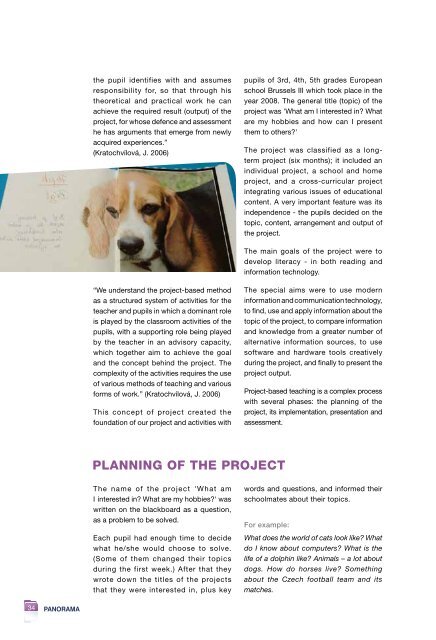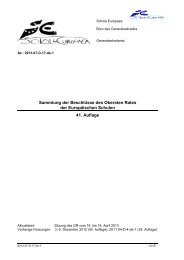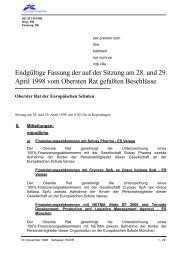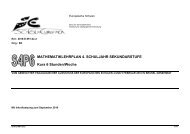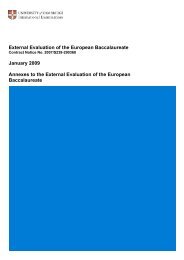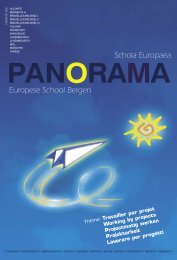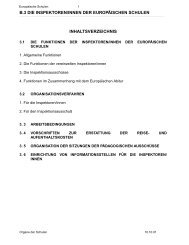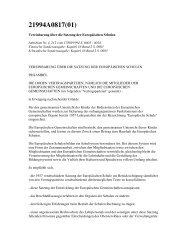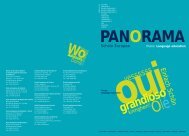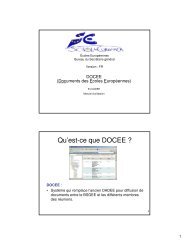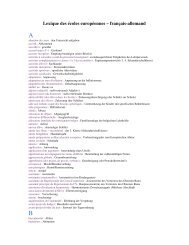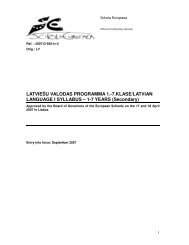Schola Europaea European School Brussels II
Schola Europaea European School Brussels II
Schola Europaea European School Brussels II
Create successful ePaper yourself
Turn your PDF publications into a flip-book with our unique Google optimized e-Paper software.
34<br />
PANORAMA<br />
the pupil identifies with and assumes<br />
responsibility for, so that through his<br />
theoretical and practical work he can<br />
achieve the required result (output) of the<br />
project, for whose defence and assessment<br />
he has arguments that emerge from newly<br />
acquired experiences.”<br />
(Kratochvílová, J. 2006)<br />
“We understand the project-based method<br />
as a structured system of activities for the<br />
teacher and pupils in which a dominant role<br />
is played by the classroom activities of the<br />
pupils, with a supporting role being played<br />
by the teacher in an advisory capacity,<br />
which together aim to achieve the goal<br />
and the concept behind the project. The<br />
complexity of the activities requires the use<br />
of various methods of teaching and various<br />
forms of work.” (Kratochvílová, J. 2006)<br />
This concept of project created the<br />
foundation of our project and activities with<br />
PLANNING OF THE PROJECT<br />
The name of the project 'What am<br />
I interested in? What are my hobbies?' was<br />
written on the blackboard as a question,<br />
as a problem to be solved.<br />
Each pupil had enough time to decide<br />
what he/she would choose to solve.<br />
(Some of them changed their topics<br />
during the first week.) After that they<br />
wrote down the titles of the projects<br />
that they were interested in, plus key<br />
pupils of 3rd, 4th, 5th grades <strong>European</strong><br />
school <strong>Brussels</strong> <strong>II</strong>I which took place in the<br />
year 2008. The general title (topic) of the<br />
project was 'What am I interested in? What<br />
are my hobbies and how can I present<br />
them to others?'<br />
The project was classified as a longterm<br />
project (six months); it included an<br />
individual project, a school and home<br />
project, and a cross-curricular project<br />
integrating various issues of educational<br />
content. A very important feature was its<br />
independence - the pupils decided on the<br />
topic, content, arrangement and output of<br />
the project.<br />
The main goals of the project were to<br />
develop literacy - in both reading and<br />
information technology.<br />
The special aims were to use modern<br />
information and communication technology,<br />
to find, use and apply information about the<br />
topic of the project, to compare information<br />
and knowledge from a greater number of<br />
alternative information sources, to use<br />
software and hardware tools creatively<br />
during the project, and finally to present the<br />
project output.<br />
Project-based teaching is a complex process<br />
with several phases: the planning of the<br />
project, its implementation, presentation and<br />
assessment.<br />
words and questions, and informed their<br />
schoolmates about their topics.<br />
For example:<br />
What does the world of cats look like? What<br />
do I know about computers? What is the<br />
life of a dolphin like? Animals – a lot about<br />
dogs. How do horses live? Something<br />
about the Czech football team and its<br />
matches.


